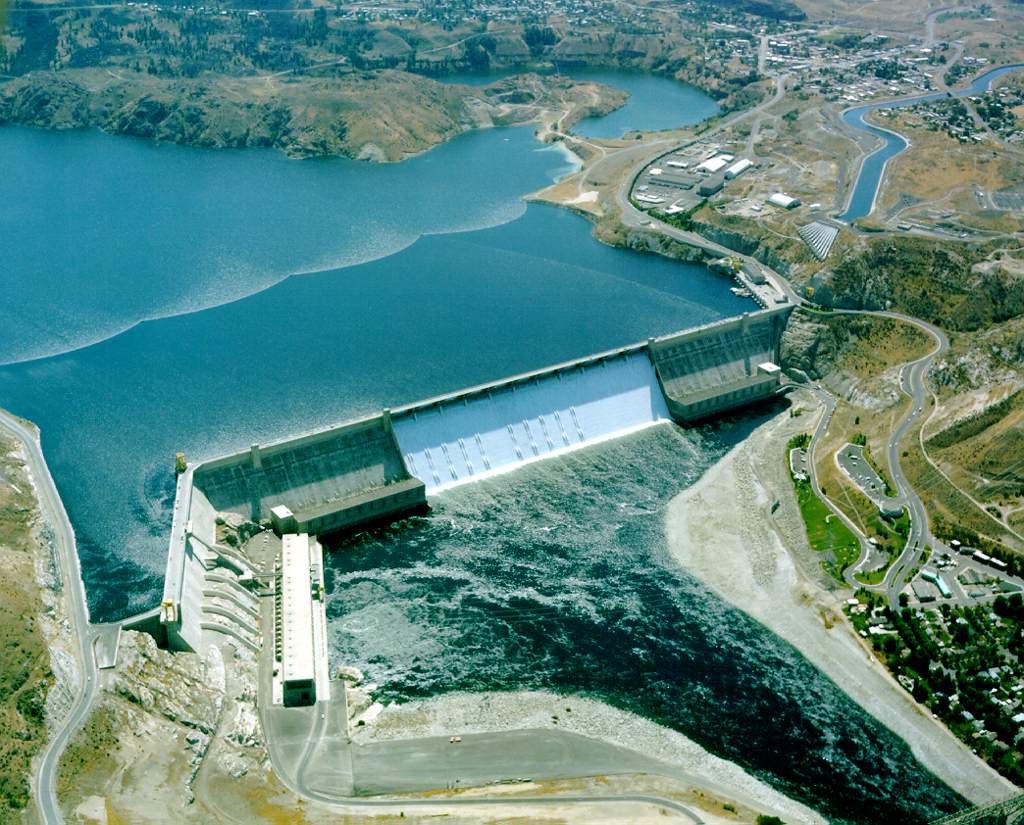Habitat Potential
Analysis suggests adequate habitat for salmon and steelhead above Chief Joseph and Grand Coulee dams.
- May 01, 2018
- John Harrison
Habitat upstream from Chief Joseph and Grand Coulee dams, in Lake Rufus Woods, Lake Roosevelt, and Columbia River tributaries, has the potential to support many thousands, perhaps millions, of salmon and steelhead, analyses by the Spokane Tribe of Indians and the Colville Confederated Tribes indicates. Ocean-going fish have been blocked from the upper Columbia River by Grand Coulee since the late 1930s, and by Chief Joseph Dam, the next dam downriver, completed in 1955.

Fish biologists Casey Baldwin of the Colville Tribes and Conor Giorgi of the Spokane Tribe discussed the analyses in a session of the Lake Roosevelt Forum conference in Spokane in late April. The session, entitled “Sneak Peek of Phase 1 Report: Upper Columbia Fish Passage and Reintroduction,” featured reports on studies being conducted in the United States and British Columbia regarding reintroducing anadromous – ocean-going-- fish above the two dams. In the United States some of the work is being done by the Colville Tribes and the Spokane Tribe, both of whose reservations border on Lake Roosevelt.
A provision in the Council’s 2014 Columbia River Basin Fish and Wildlife Program calls for a three-phase investigation of reintroducing salmon and steelhead above the two dams. The work so far is in response to Phase 1, an analysis of potential habitat and donor stocks of fish, which the tribes expect to complete this summer. The Council awarded a contract to the Spokane Tribe for the Phase 1 analysis in March 2016. The Council has not voted on whether to support reintroduction. The three-phased investigation, with each phase increasing in focus and detail, is intended to inform that decision in the future.
Baldwin said 40 stocks had been identified and ranked for their reintroduction feasibility based on criteria such as the least impact on downstream stocks and resident fish, disease history of the species, and compatibility with the upper Columbia environment. The stocks included seven sockeye, 10 summer/fall Chinook, 10 spring Chinook, seven steelhead, and six coho populations. While some of these populations are ESA-listed, he said the tribes are committed to reintroduction with fish that are not listed.
Giorgi said research using the Ecosystem Diagnosis and Treatment model and publicly available Geographic Information Systems (GIS) data has identified 1,161 miles of potential tributary habitat for steelhead and 355 miles for spring Chinook. In terms of adult fish, this equates to a maximum of 4,168 steelhead, 13,339 spring and summer Chinook, and between 34,066 and more than 1 million sockeye. The sockeye assessment was for the San Poil River system. Lake Rufus Woods, the reservoir behind Chief Joseph Dam, has the habitat capacity to support around 600 to 20,000 summer/fall Chinook and Lake Roosevelt behind Grand Coulee could support between 12 million and 48.5 million sockeye, he said.
Meanwhile, Bill Green of the Ktunaxa Nation Council in Cranbrook said the Nation has been working with U.S. tribes and others on the habitat feasibility assessment and has undertaken its own similar studies north of the border, which he said “line up perfectly” with the work south of the border. He said the research results to date indicate the transboundary reach of the Columbia is predicted to have suitable habitat for at least hundreds, and perhaps thousands, of Chinook spawning pairs. He said suitable donor stocks are likely available for this reach, most likely a species of summer/fall Chinook. He said the studies to date are not comprehensive regarding whether reintroduction is feasible, “but they provide encouraging support of the feasibility and the approach.” The work to date also does not address the potential cost of reintroduction, but that experimental releases of fish, with risk assessment and careful monitoring, “will be far more informative” regarding cost. A possible source of multi-year funding is a program run by Environment and Climate Change Canada, the federal environmental agency, that mitigates environmental damages, he said.
Links to presentations:
- John Sirois, Colville Confederated Tribes, overview the Upper Columbia United Tribes and the history of anadromous fish above Chief Joseph and Grand Coulee: https://bit.ly/2rbgklc
- Casey Baldwin, Colville Confederated Tribes, donor stock and risk assessment: https://bit.ly/2JBdKMT
- Conor Giorgi and Casey Baldwin, Phase 1 habitat assessments: https://bit.ly/2w06t7t
- Bill Green, Ktunaxa Nation Council, efforts to restore anadromous salmon to the Canadian Columbia River Basin: https://bit.ly/2HG8C9z
- Steve Smith, consultant to the Upper Columbia United Tribes, anadromous fish reintroduction thoughts on the future: https://bit.ly/2r9Vh2o


